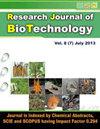Identification of potential inhibitors from Andrographis paniculata bioactive compounds against extended-spectrum β-lactamases through in silico and in vitro approaches
IF 0.2
Q4 BIOTECHNOLOGY & APPLIED MICROBIOLOGY
引用次数: 0
Abstract
The present study aims to identify potential medicinal plant-based extended-spectrum β-lactamase (ESBL) inhibitors from Andrographis paniculata using both in silico and in vitro approaches. The ESBLs were obtained from the protein data bank. The structures of phytoconstituents were obtained from the PubChem database. The compounds were docked against different ESBLs (targeted proteins) using AutodockTools followed by molecular dynamics simulation. In silico results were further validated using in vitro testing through the disc diffusion method. The molecular docking revealed that most of the phytoconstituents have a good binding affinity. The binding energy and in vitro study of the phytoconstituents of Andrographis paniculata were compared with the standard inhibitor for ESBL i.e. clavulanic acid .14- Acetylandrographolide (AAD) showed good binding with the ESBL proteins, having the best values reported in the docking with OXA-10. Simulation of the complex of AAD and OXA-10 showed that the complex was relatively steady as evidenced by the lack of sudden fluctuations in the values of root mean square deviations, the radius of gyration and solvent-accessible surface area. Further confirmation of the in silico approach was done by an in vitro study against ESBL-producing organisms which showed inhibitory results. From this study, we can conclude that A.paniculata may have the potential to inhibit ESBLs and may be considered for treating bacterial infections.通过硅学和体外方法鉴定穿心莲生物活性化合物对广谱β-内酰胺酶的潜在抑制剂
本研究旨在利用硅学和体外方法从穿心莲中鉴定潜在的药用植物型广谱β-内酰胺酶(ESBL)抑制剂。ESBLs是从蛋白质数据库中获得的。植物成分的结构来自 PubChem 数据库。使用 AutodockTools 对化合物与不同的 ESBLs(目标蛋白)进行对接,然后进行分子动力学模拟。通过圆盘扩散法进行体外测试,进一步验证了硅学结果。分子对接结果表明,大多数植物成分具有良好的结合亲和力。穿心莲植物成分的结合能和体外研究结果与 ESBL 标准抑制剂克拉维酸进行了比较。对 AAD 和 OXA-10 复合物的模拟显示,该复合物相对稳定,均方根偏差、回旋半径和可溶解表面积的值没有突然波动。针对产生 ESBL 的生物体进行的体外研究进一步证实了这种硅学方法,研究结果显示了抑制作用。通过这项研究,我们可以得出结论:A.paniculata 具有抑制 ESBLs 的潜力,可用于治疗细菌感染。
本文章由计算机程序翻译,如有差异,请以英文原文为准。
求助全文
约1分钟内获得全文
求助全文
来源期刊

Research Journal of Biotechnology
BIOTECHNOLOGY & APPLIED MICROBIOLOGY-
CiteScore
0.60
自引率
0.00%
发文量
192
期刊介绍:
We invite you to contribute Research Papers / Short Communications / Review Papers:
-In any field of Biotechnology, Biochemistry, Microbiology and Industrial Microbiology, Soil Technology, Agriculture Biotechnology.
-in any field related to Food Biotechnology, Nutrition Biotechnology, Genetic Engineering and Commercial Biotechnology.
-in any field of Biotechnology related to Drugs and Pharmaceutical products for human beings, animals and plants.
-in any field related to Environmental Biotechnolgy, Waste Treatment of Liquids, Soilds and Gases; Sustainability.
-in inter-realted field of Chemical Sciences, Biological Sciences, Environmental Sciences and Life Sciences.
-in any field related to Biotechnological Engineering, Industrial Biotechnology and Instrumentation.
-in any field related to Nano-technology.
-in any field related to Plant Biotechnology.
 求助内容:
求助内容: 应助结果提醒方式:
应助结果提醒方式:


